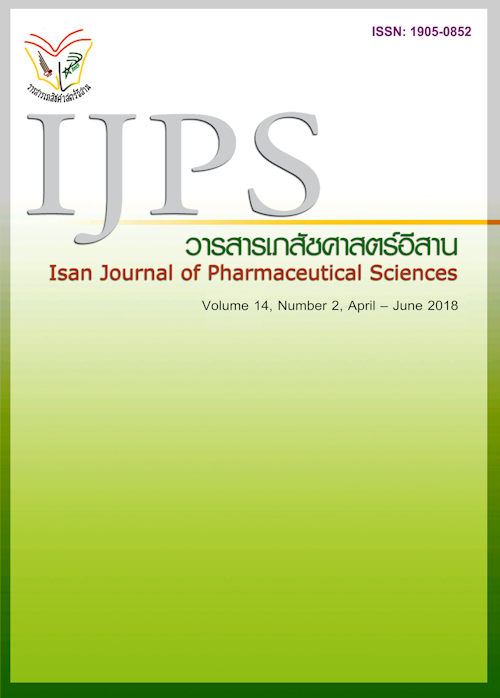Myasthenia Gravis
Main Article Content
Abstract
Myasthenia gravis (MG) is an autoimmune disease that affects the neuromuscular junction. In Thailand, MG affects approximately 2.17 patients per 100,000 population. MG is primary caused by autoantibodies directingtowards the nicotinic acetylcholine receptors at the post synaptic membrane leading to muscle weakness. The clinical characteristic signs and symptoms of myasthenia gravisare ptosis, diplopia, weakness in chewing, difficult in swallowing andfluctuating levels of skeletal muscle weakness. The severity of weakness and fatigability fluctuates during the day, usually being least severe in the morning and worse as the day progress, especially during exercise orcontinuous repetitive motion with at least partially restored strength after period of rest. There are two approaches for management of MG based on the pathophysiology of this disease. The first treatment is by increasing the amount of acetylcholine that is available to bind with the nicotinic acetylcholine receptor at postsynaptic membrane using an acetylcholinesterase inhibitor agent. The second approach is by using immunosuppressive medications that can reducethe binding of nicotinic acetylcholine receptorsby antibodies.
Article Details
In the case that some parts are used by others The author must Confirm that obtaining permission to use some of the original authors. And must attach evidence That the permission has been included
References
Ahmed A and Milind Kothari DO. Myasthenia Gravis: An Updated Review. Austin J Musculoskelet Disord. 2016; 3(2): 1032.
Almeida DF, Radaeli Rde F, Melo Jr AC. Ice pack test in the diagnosis of myasthenia gravis. Arq Neuropsiquiatr. 2008; 66 (1): 96-8.
Ballanti E, Perricone C, Greco E, Ballanti M, Di Muzio G, Chimenti MS, et al. Complement and autoimmunity. Immunol Res. 2013; 56 (2-3): 477-91.
Batocchi AP, Evoli A, Di Schino C, Tonali P. Therapeutic apheresis in myasthenia gravis. Ther Apher. 2000; 4 (4): 275-9.
Boron WF and Boulpaep EL. (2005). Medical Physiology (Updated Edition). Philadelphia: The Curtis Center.
Chan KH, Lachance DH, Harper CM, Lennon VA. Frequency of seronegativity in adult-acquired generalized myasthenia gravis. Muscle Nerve. 2007; 36(5): 651-8.
Conti-Fine BM, Milani M, Kaminski HJ. Myasthenia gravis: past, present, and future. J Clin Invest. 2006; 116 (11): 2843-54.
Evoli A, Tonali PA, Padua L, Monaco ML, Scuderi F, Batocchi AP, et al. Clinical correlates with anti-MuSK antibodies in generalized seronegative myasthenia gravis. Brain. 2003; 126 (Pt 10): 2304-11.
Guyton AC and Hall JE. (2006). Textbook of Medical Physiology, 11th Edition. Philadelphia: Elsevier Inc.
Ha JC, Richman DP. Myasthenia gravis and related disorders: Pathology and molecular pathogenesis. Biochim Biophys Acta. 2014; 1852(4): 651-7.
Hoffmann M, Rychlewski J, Chrzanowska M, Hermann T. Mechanism of activation of an immunosuppressive drug: azathioprine. Quantum chemical study on the reaction of azathioprine with cysteine. J Am Chem Soc. 2001; 123 (26): 6404-9.
Jacob S, Viegas S, Lashley D, Hilton-Jones D. Myasthenia gravis and other neuromuscular junction disorders. Pract Neurol. 2009; 9 (6): 364-71.
Jayam Trouth A, Dabi A, Solieman N, Kurukumbi M, Kalyanam J. Myasthenia gravis: a review. Autoimmune Dis. 2012: 874680.
Kim JY, Park KD, Richman DP. Treatment of myasthenia gravis based on its immunopathogenesis. J Clin Neurol. 2011; 7 (4): 173-83.
Klemencic SA, Condie J, Mei D. Ocular and generalized myasthenia gravis: a teaching case series. Optometric education. 2014; 39(3): 129-37.
Kusner LL, Kaminski HJ, Soltys J. Effect of complement and its regulation on myasthenia gravis pathogenesis. Expert Rev Clin Immunol. 2008; 4 (1): 43-52.
Levinson AI, Song D, Gaulton G, Zheng Y. The intrathymic pathogenesis of myasthenia gravis. Clin Dev Immunol. 2004; 11 (3-4): 215-20.
Meriggioli MN, Sanders DB. Advances in the diagnosis of neuromuscular junction disorders. Am J Phys Med Rehabil. 2005; 84 (8): 627-38.
Meriggioli MN, Sanders DB. Muscle autoantibodies in myasthenia gravis: beyond diagnosis? Expert Rev Clin Immunol. 2012; 8 (5): 427-38.
Nacu A, Andersen JB, Lisnic V, Owe JF, Gilhus NE. Complicating autoimmune diseases in myasthenia gravis: a review. Autoimmunity. 2014; 48 (6): 362-8.
Pascuzzi RM, Coslett HB, Johns TR. Long-term corticosteroid treatment of myasthenia gravis: report of 116 patients. Ann Neurol. 1984; 15 (3): 291-8.
Pascuzzi RM. The edrophonium test. Semin Neurol. 2003; 23 (1): 83-8.
Pohanka M. Inhibitors of acetylcholinesterase and butyrylcholinesterase meet immunity. Int J Mol Sci. 2014; 15 (6): 9809-25.
Psaridi-Linardaki L, Trakas N, Mamalaki A, Tzartos SJ. Specific immunoadsorption of the autoantibodies from myasthenic patients using the extracellular domain of the human muscle acetylcholine receptor alpha-subunit. Development of an antigen-specific therapeutic strategy. J Neuroimmunol. 2005; 159 (1-2): 183-91.
Samuelsson A, Towers TL, Ravetch JV. Anti-inflammatory activity of IVIG mediated through the inhibitory Fc receptor. Science. 2001; 291 (5503): 484-6.
Skeie GO, Apostolski S, Evoli A, Gilhus NE, Hart IK, Harms L, et al. Guidelines for the treatment of autoimmune neuromuscular transmission disorders. Eur J Neurol. 2006; 13 (7): 691-9.
Tiamkao S. Common pitfalls in myasthenia gravis. J North-Eastern Neurosci. 2011; 6 (3): 159-68.
Tiamkao S. Myasthenia Gravis. J North-Eastern Neurosci. 2007; 2: 21-9.
Tiamkao S., Pranboon S., Thepsuthammarat K. and Sawanyawisuth K. Prevalence of factors associated with poor outcomes of hospitalized myasthenia gravis patients in Thailand. J. Neurosci. 2014; 19 (4): 286-90.


